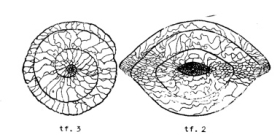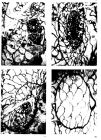Foraminifera taxon details
Acervoschwagerina Hanzawa, 1949 †
721850 (urn:lsid:marinespecies.org:taxname:721850)
accepted
Genus
Paraschwagerina (Acervoschwagerina) endoi Hanzawa, 1949 † accepted as Acervoschwagerina endoi (Hanzawa, 1949) † (type by original designation)
Paraschwagerina (Acervoschwagerina) Hanzawa, 1949 † · unaccepted (Opinion of Miklukho-Maklay (1955)...)
Opinion of Miklukho-Maklay (1955) Nomen translatum
- Species Acervoschwagerina baomoshanensis Zhang, 1979 †
- Species Acervoschwagerina endoi (Hanzawa, 1949) †
- Species Acervoschwagerina fujimotoi Kanuma, 1959 †
- Species Acervoschwagerina gongendaniensis Kobayashi in Kobayashi & Furutani, 2019 †
- Species Acervoschwagerina indolasa Sosnina, 1965 †
- Species Acervoschwagerina inusitata Lin, 1977 †
- Species Acervoschwagerina kagemoriensis (Huzimoto, 1936) †
- Species Acervoschwagerina maclayi Daydov in Davydov et al., 1996 †
- Species Acervoschwagerina tsharymdarensis (Leven, 1992) †
marine, brackish, fresh, terrestrial
fossil only
feminine
(of Paraschwagerina (Acervoschwagerina) Hanzawa, 1949 †) Hanzawa, S. (1949). A New Type of the Fusulinid Foraminifera from Central Japan. <em>Journal of Paleontology.</em> 23(2): 205-209.
page(s): p. 207 [details] Available for editors [request]
[request]
page(s): p. 207 [details] Available for editors
Diagnosis Test large, may exceed 18 mm in length, robustly fusiform, poles rounded to bluntly pointed, axis of coiling straight,...
Diagnosis Test large, may exceed 18 mm in length, robustly fusiform, poles rounded to bluntly pointed, axis of coiling straight, elongate fusiform juvenarium of two to three low volutions that are closely coiled about the small spherical proloculus, followed by two or three rapidly enlarging whorls that may exceed 1.5 mm in height, septa in the juvenarium regularly and highly fluted, in later whorls the extremely irregular fluting to the tops of the chambers may produce a number of vesicular chamberlets in the height of a single chamber; wall thin, alveolar; small chomata present in the inner whorls, narrow tunnel with irregular path and increasing unevenly in width with growth, may be roofed by phrenothecalike layers. L. Permian (Sakmarian); Japan. (Loeblich & Tappan, 1987, Foraminiferal Genera and Their Classification) [details]
Hayward, B.W.; Le Coze, F.; Vachard, D.; Gross, O. (2025). World Foraminifera Database. Acervoschwagerina Hanzawa, 1949 †. Accessed at: https://www.marinespecies.org/foraminifera/aphia.php?p=taxdetails&id=721850 on 2025-05-22
Date
action
by
original description
(of Paraschwagerina (Acervoschwagerina) Hanzawa, 1949 †) Hanzawa, S. (1949). A New Type of the Fusulinid Foraminifera from Central Japan. <em>Journal of Paleontology.</em> 23(2): 205-209.
page(s): p. 207 [details] Available for editors [request]
[request]
basis of record Loeblich, A. R.; Tappan, H. (1987). Foraminiferal Genera and their Classification. Van Nostrand Reinhold Company, New York. 970pp., available online at https://books.google.pt/books?id=n_BqCQAAQBAJ [details] Available for editors [request]
[request]
page(s): p. 207 [details] Available for editors
basis of record Loeblich, A. R.; Tappan, H. (1987). Foraminiferal Genera and their Classification. Van Nostrand Reinhold Company, New York. 970pp., available online at https://books.google.pt/books?id=n_BqCQAAQBAJ [details] Available for editors
From editor or global species database
Diagnosis Test large, may exceed 18 mm in length, robustly fusiform, poles rounded to bluntly pointed, axis of coiling straight, elongate fusiform juvenarium of two to three low volutions that are closely coiled about the small spherical proloculus, followed by two or three rapidly enlarging whorls that may exceed 1.5 mm in height, septa in the juvenarium regularly and highly fluted, in later whorls the extremely irregular fluting to the tops of the chambers may produce a number of vesicular chamberlets in the height of a single chamber; wall thin, alveolar; small chomata present in the inner whorls, narrow tunnel with irregular path and increasing unevenly in width with growth, may be roofed by phrenothecalike layers. L. Permian (Sakmarian); Japan. (Loeblich & Tappan, 1987, Foraminiferal Genera and Their Classification) [details]


